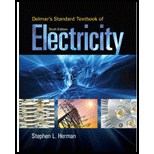
Mindtap Electrical, 4 Terms (24 Months) Printed Access Card For Herman's Delmar's Standard Textbook Of Electricity, 6th (mindtap Course List)
6th Edition
ISBN: 9781305634312
Author: Herman, Stephen L.
Publisher: Cengage Learning
expand_more
expand_more
format_list_bulleted
Concept explainers
Question
Chapter 24, Problem 6RQ
To determine
The voltage dropped across the resistor, capacitor and the inductor in the series RLC circuit.
Expert Solution & Answer
Want to see the full answer?
Check out a sample textbook solution
Students have asked these similar questions
I am seeking ideas or references regarding the auxiliary power output for a trolley. I’ve encountered difficulties finding information online about the power output for lights, buzzers, and speakers. Specifically, I am interested in the following questions:
How many lights, buzzers, and speakers can a trolley approximately 48 feet in length accommodate?How can I determine their rated power?Any guidance or resources you can provide would be greatly appreciated.
Thank you!
5.
Three single-phase transformers rated at 250 kVA, 7200 V/600 V, 60 Hz, are
connected in wye-delta on a 12470 V, 3-phase line. If the load is 450 kVA, calculate the following
currents:
(1) In the incoming and outgoing transmission lines
(2) In the primary and secondary windings
(3) If this transformer is used to raise the voltage of a 3-phase, 600 V line to 7.2 kV. (a) How
must they be connected? (b) Calculate the line currents for a 600 kVA load. (c) Calculate the
corresponding primary and secondary currents.
please answer handwritten not chatgbt
Chapter 24 Solutions
Mindtap Electrical, 4 Terms (24 Months) Printed Access Card For Herman's Delmar's Standard Textbook Of Electricity, 6th (mindtap Course List)
Ch. 24 - What is the phase angle relationship of current...Ch. 24 - What is the phase angle relationship of current...Ch. 24 - What is the phase angle relationship of current...Ch. 24 - An AC circuit has a frequency of 400 Hz. A 16-...Ch. 24 - If 440 V are connected to the circuit, how much...Ch. 24 - Prob. 6RQCh. 24 - What is the true power of the circuit in Question...Ch. 24 - What is the apparent power of the circuit in...Ch. 24 - What is the power factor of the circuit in...Ch. 24 - How many degrees are the voltage and current out...
Ch. 24 - You are an electrician working in a plant. A...Ch. 24 - Prob. 1PPCh. 24 - The circuit is connected to a 400-Hz line with an...Ch. 24 - The circuit is connected to a 60-Hz line. The...Ch. 24 - This circuit is connected to a 1000-Hz line. The...Ch. 24 - A series RLC circuit contains a 4-k resistor, an...Ch. 24 - A series RLC circuit contains a resistor with a...Ch. 24 - Is the power factor in Question 6 a leading or...Ch. 24 - A series RLC circuit contains a resistor with a...Ch. 24 - A series RLC circuit has an applied voltage of 240...Ch. 24 - A series RLC circuit is connected to a 60-Hz power...
Knowledge Booster
Learn more about
Need a deep-dive on the concept behind this application? Look no further. Learn more about this topic, electrical-engineering and related others by exploring similar questions and additional content below.Similar questions
- Solve without using alarrow_forwardDon't use ai to answer I will report you answerarrow_forwardThe values of the elements in the circuit given in the figure are given below. Find the maximum average power that can be transferred to the ZL load. Vg=5cos(10000t) VoltR=38 kilo ohmC=35 nano faradL=150 milli henryarrow_forward
- Prelab Information 1. Laboratory Preliminary Discussion Second-order RC Circuit Analysis The second-order RC circuit shown in figure 1 below represents all voltages and impedances as functions of the complex variable, s. Note, of course, that the impedances associated with Rs, R₁, and R2 are constant independent of frequency, so the 's' notation is omitted. Again, one of the advantages of s-domain analysis is that we can apply all of the circuit analysis techniques learned for AC and DC circuits. To generate the s-domain expression for the output voltage, Vout(s) = Vc2(s), for the circuit shown in figure 1, we can apply voltage division in the s-domain as shown in equation 1 below. Equation 1 will be used in the prelab computations to find an expression for the output voltage, vc2(t), in the time domain. Note also that when we collect frequency response data for the circuit it will be operating at AC steady-state conditions for each frequency tested. Note that under AC steady-state…arrow_forwardDon't use ai to answer I will report you answerarrow_forwardThe power values of the loads in the circuit given in the figure are given below. Accordingly, which of the following is the RMS value of the Vs voltage amplitude? Load 1 (L1): the power factor is 1 and draws 13 kW of power,Load 2 (L2): draws 1 kVA at a forward power factor of 0.6,Load 3 (L3): draws 4 kW of average power and gives 3 kVAR of reactive power.arrow_forward
- The values of the elements in the circuit given in the figure are given below. Find the average power value on the R2 resistor. (Hint: First find the current of the R2 resistor with the loop current method. Four mutual inductance effect expressions should be added to each of the two loop equations.) Vs=238 voltsR1=13 ohmsR2=15 ohmsarrow_forwardDon't use ai to answer I will report you answerarrow_forwardA transformer bank is composed of three single-phase transformers of10kVA, 20kV/200V; copper losses are 100 W and core lossesthey are 50 W. The bank is connected in Delta on the high voltage side and in star on the sidethe low-voltage side. A. What are the values of voltages B.What are the values of currents C. losses in the core and losses in copper. D. nominal power of the transformer bank.Solve by one of the experts, not using artificial intelligencearrow_forward
arrow_back_ios
SEE MORE QUESTIONS
arrow_forward_ios
Recommended textbooks for you
 EBK ELECTRICAL WIRING RESIDENTIALElectrical EngineeringISBN:9781337516549Author:SimmonsPublisher:CENGAGE LEARNING - CONSIGNMENT
EBK ELECTRICAL WIRING RESIDENTIALElectrical EngineeringISBN:9781337516549Author:SimmonsPublisher:CENGAGE LEARNING - CONSIGNMENT

EBK ELECTRICAL WIRING RESIDENTIAL
Electrical Engineering
ISBN:9781337516549
Author:Simmons
Publisher:CENGAGE LEARNING - CONSIGNMENT